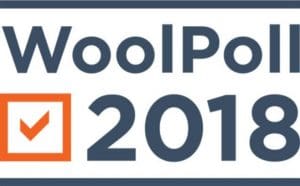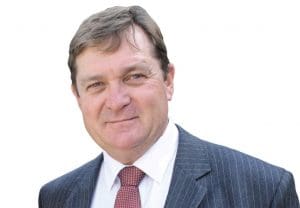 ACCURATE wool production and price forecasts have become a factor for Australian growers preparing to vote in WoolPoll 2018 this month.
ACCURATE wool production and price forecasts have become a factor for Australian growers preparing to vote in WoolPoll 2018 this month.
The industry’s growers seem to be aligning around two main options – 1.5 percent and 2pc — of the five up for consideration — 0 percent, 1.5pc, 2pc, 2.5pc and 3pc.
However, with the drought continuing across New South Wales and Queensland, dry conditions in South Australia and Victoria creeping southward, continuing sales of Merino ewes to slaughter and reports of poor marking percentages, recent wool production forecasts are being questioned.
Australian Wool Innovation is urging its shareholders to vote to continue the current 2 percent levy on their gross proceeds for a further three years from 2019, in the WoolPoll 2018 ballot that opens on 17 September and closes at 5pm (AEDT) on 2 November 2018.
However, peak wool grower body WoolProducers Australia and the Australian Wool Growers Association have come out in support of 1.5pc, and other breeder bodies have chosen not to recommend a specific option to their members.
Australian Association of Stud Merino Breeders president Peter Meyer said the association had submitted its preferred levy range to the WoolPoll panel, but was not recommending that AWI shareholders vote for a specific option.
“We submitted 0, 1pc, 1.5pc, 2pc and 2.5pc, but is up to the commercial growers to make their own mind.”
Australian Superfine Wool Growers Association president Danny Picker also said it was not making a specific WoolPoll recommendation to members, although he personally felt that “2 percent is where we need to be.”
“We need to continue more than ever to promote and innovate our product.
“This decision is for the individual farmer to decide,” he said.
NSW broker and AWI director raises wool forecast concerns

NSW wool broker and AWI director Don Macdonald
However, New South Wales wool broker and grower Don Macdonald this week came out in support of AWI’s position on the 2018 WoolPoll vote, citing concerns about future wool production and price levels.
Mr Macdonald is also the latest member of the AWI board, but said he was not speaking on behalf of the AWI, although he said the company’s directors were unanimous on its 2pc recommendation.
“I haven’t been sanctioned to be a spokesman.”
AWI’s WoolPoll 2018 budget has assumed an annual wool production of 352 million kilograms for 2019/20, with a 2pc annual increase, although the Australian Wool Production Forecasting Committee’s updated forecast of shorn wool production for 2018/19 is 322mkg greasy.
AWI’s levy rate modelling for the next WoolPoll period of 2019/20 to 2021/22 has assumed a forward wool price benchmark of EMI of 1700c/kg as the 2017/18 season average, although the voter information memorandum also quotes the 2017/18 EMI average as being 1734c/kg clean and reaching a record high of 2073c/kg. Both averages are more than 350 cents below the current EMI of 2088 cents. The average so far in 2018/19 is more than 2010c/kg. The average EMI in 2016/17 was 1401c/kg.
Mr Macdonald said the WoolPoll wool production forecasts were prepared before the latest AWPFC’s latest forecast, which were now “six to seven week’s old.” He said there was drought across New South Wales and Queensland where 40pc of the national wool clip is produced. These states produced a great proportion of the Merino clip, he said.
“The things that will affect wool production in the short term and in the longer term are Merino ewes on the ground and a lot of these areas are going to have very poor lambing.
“I think already 322 million kilograms is optimistic,” he said.
“We are moving on and AWTA figures to the end of August are already showing that the drop in production is matching the drop in production forecast by the forecasting committee.
“So the picture is going to be a lot worse after 12 months, isn’t it?”
Mr Macdonald said he was concerned that the data that AWI shareholders will be looking at is already updated, because of a “timing issue.”
“So by the time we actually get to WoolPoll and we are staring down the barrel of 310, 305, 300 million kilograms of wool, the wool market has got to sustain an incredible (price) level to actually match the fundings if you go for 1.5pc.”
Wool price resistance feedback
Mr Macdonald said there has also been market feedback of resistance to recent price rises.
“And the point is that we can’t lock in a 2100 cent market indicator and we can’t lock in a 2000 cent indicator.
“We are starting to hear a few stories from other downstream processors that the top makers and even in China — what comes out of Nanjing this week will be interesting – there are mills that are talking about closing the doors because it is cheaper to close the doors and pay the wages, than buy the wool and lose money,” he said.
“That was from a show floor buyer for one of the major Chinese trading companies.”
Mr Macdonald believed that the fine wool prices would be “ok” despite the influence of drought-affected wools, but he was concerned about the historically high price levels for sectors such as cardings, fine crossbreds and coarse Merinos.
“If the market correct and falls back, I suspect it will be in those areas, more than genuine fine wool.
“Trying to pick a number on where this markets is going to average over three or four years is a bit of a lottery, but you are a game man if your factor a price in and say that is where it is going to be for the next three or four years.”
When asked about AWI’s current reserves and its 2017-18 levy income, Mr Macdonald expected these details would be available when the audited accounts are released.
“When they are voting on WoolPoll, they should have that information at hand.
“I would like to think (as a wool grower) that that information will come out, but that’s not my call,” he said.
“And it is something I will be asking.”
Mr Macdonald said he has had no feedback from growers at ram sales in drought-affected areas that AWI was receiving too much money from the current levy, especially for marketing
“They are all saying we have got this market where we want it, we want to keep it there.
“And we don’t want to keep it there just because we’ve got no wool or fall back on our laurels because we’ve got some reserves there.”
But he said if the 1.5pc “gets up” and wool production falls back to 300mkg, AWI would have to take a different view on how it “rations” levy funds.
“There is going to have to a lot of re-budgeting done and a lot of programs shelved – that’s just commonsense – because we can’t stay on a line where we end up with no reserves.”
A 2pc levy will allow more R&D programs – AWI
AWI is claiming in the WoolPoll 2018 voter information memorandum that a 2pc levy will build the company’s capacity to deliver more through current core R&D and marketing programs. Retaining the 2pc levy would also allow AWI to maintain its forward contracts, operating, emergency animal and discretionary reserves at “a responsible level,” the company has said.
AWI has also said it is not viable to maintain the level of investment in reseach and development and marketing at 1.5pc in the long term. The company has said it would have no capacity to invest in new investment opportunities and no buffer in its budget against any future wool price volatility, meaning existing programs may have to be discontinued.
AWGA says 2pc levy is ‘too greedy’

Chick Olsson
In a letter to the editor this week, AWGA director Chick Olsson said by putting 1.5pc as their first preference wool growers will allow AWI to continue to function on an equal revenue stream to last year, owing to higher wool prices.
“AWI’s public calls for 2pc is truly greedy, knowing how many are suffering at the moment.
“Saving 0.5pc of your gross wool cheque is much needed to feed stock and keep the farm running and/ or, maybe take the family for a much-needed holiday,” he said.
“As a second preference, by voting 0pc, you will ensure that the weighted preference WoolPoll voting system ensures a 1.5pc levy.
“WoolPoll is vastly weighted to ensure AWI gets a 2pc levy,” Mr Olsson said.
Mr Olsson said zero levy result would force AWI to become a proper public company and issue shares to every previous wool tax payer. Click here to read Mr Olsson’s complete letter.
WPA figures favour 1.5pc even with less wool

WoolProducers vice president Ed Storey
WoolProducers Australia vice president Ed Storey said a 1.5pc levy would give AWI the most money over the next three years from 2019 that it has ever had.
Mr Storey conceded that wool production is likely to be below the latest forecast.
“But we still believe that the current reserves as at 30 June 2018 will be above expectations.
“1.5pc, even allowing for a serious production shock in the seasonal conditions, will allow it to do more marketing and more R&D than it has ever done before.”
Mr Storey could not confirm AWI’s reserves figure or what AWI’s 2017-18 levy income was.
Bur Mr Storey said is AWI spends about $100 million annually in the next four years WPA estimated AWI’s reserves would finish well above the minimum of $60 million needed for wind-up and contracts.
“We believe their reserves will finish up over $70 million.
“We’ve factored in the realistic probability that there will be a significant fall in production,” he said.
Mr Storey said a 1.5pc levy would not make the company unsustainable, untenable, or unable to continue its work.
“Two percent, we believe, is too high – the best way to boost production under these seasonal conditions it to just leave a little bit on the table for growers.”
Mr Storey said it was important for AWI shareholders to understand the WoolPoll preferential voting system. He urged growers to preference their votes and not just nominate one option.
“If you choose just one option and you choose one of the options that not many of the other growers choose, and you don’t preference, your vote will count for nothing.”
Voters voting for 1.5pc should put a ‘1’ in the 1.5pc box and preference another option, he said.
WAFarmers opts for 1.5pc
WAFarmers also today encouraged wool growers to choose the 1.5pc levy voting option as their first preference in the 2018 WoolPoll.
WAFarmers Livestock Council vice president Steve McGuire said that the 1.5 percent levy rate option will provide sufficient funds for AWI to operate.
“AWI’s spending has increased from $70 million in 2015-16, $88 million in 2016-17 to a budgeted $110 million for the current financial year.
“AWI is proposing to maintain this $110 million expenditure over the next four years, which would mean it would be spending nearly half a billion dollars over that time,” Mr McGuire said.
“AWI is required to have enough reserves available to cover the winding up of the company and provision for a disease outbreak.
“At the end of the last financial year, the reserve amount stood at approximately $121 million,” he said.
“Even with a $10 million drop in expenditure, AWI would still have sufficient reserves to cover the statutory reserve requirements.
“WAFarmers do not think an expenditure of half a billion dollars over four years is necessary and the 1.5pc levy rate, along with government match funding contribution, plus the significant reserves held, will provide sufficient funds for AWI to complete the appropriate research, development and marketing required.”
Click here for more information on WoolPoll 2018 and the voter information memorandum.

“The sky is falling” “We’ll all be rooned.”
Blah Blah Blah AWI – get on with it and stop talking the wool market down.